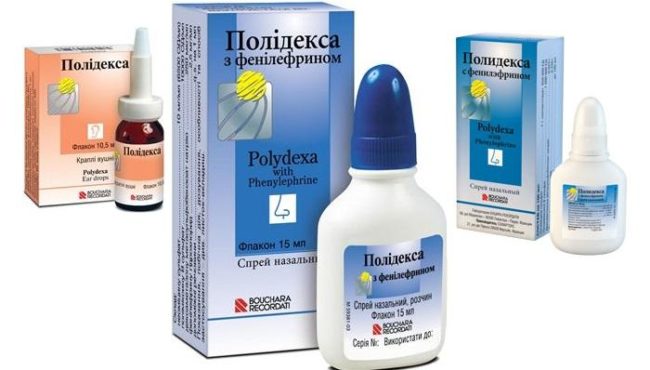SARS, influenza or ordinary colds are certainly accompanied by nasal congestion and abundant mucus secretion. Most often, this condition is caused by the formation of a pathogenic zone in the form of pathogenic organisms, which penetrate the mucous membrane of the nose, eyes and ears through the virus weakened by the virus. It is important not only to eliminate the symptoms of the disease, but to fight precisely with harmful microorganisms. For this purpose, otolaryngologists are not rarely prescribed by polydex drops. In our article you will find detailed instructions for the use of Polydex drops.
Content
Polydex: pharmacological features
Polydex drops are an extensive acting drug for the treatment of nasal mucosa for acute respiratory viral infections, influenza and colds. Active substances drop in the nose of the polydex:
- neomycin sulfate;
- polymixin sulfate;
- macrogol;
- phenylefrin hydrochloride;
- polysorbate;
- meta -sulfobenzoate;
- dexamethason;
- tiomersal.
Thanks to this composition, the drug not only reduces the release of mucus from the nose and prevents the congestion, but also fights virulent microbes. At the same time, phenylefrin promotes the narrowing of the vascular mesh and facilitates the respiratory process, dexamethason relieves inflammatory phenomena, and polymixin destroys harmful bacteria.

It is worth noting that polydex drops contain antibiotics and hormonal substances. That is why many patients, having read the instructions, beat the alarm. The justification for the use of the drug should be weighed exclusively by the doctor who is engaged in treatment. And if you have been assigned to Polydex drops, then be sure that the situation requires them. Indeed, today, a prolonged rhinitis, which after 10-15 days of unsuccessful treatment develops into purulent rhinore, is much more dangerous than taking antibiotic and hormonal agents.
It is worth noting that only a doctor can prescribe polydex, and its use should be under strict medical control. Self -medication with this drug is dangerous, incorrect dosage or a large amount of instillation in the nose during the day can turn into pernicious consequences.
Polydex drug: release form
For therapy of acute ear infections, which are associated with the formation of virulent microflora and are manifested in the form of purulent inflammations, the infectious and viral diseases of the intermediate and external auditory passage are prescribed ear droplets of polydex. Drops are stored in bottles of 11 milliliters of red glass. The drop in the kit also includes a special pipette, which is designed for dosage accuracy and convenience when instilled into the auditory entrance.
The nasal form of the drug is made in the form of a spray or drops in the nose of the polydex. The bottle is a small container of non -translucent plastic material with a capacity of 16 milliliters. Included with a spray, there is a plastic tip, narrowed to the top for the convenience of injecting.
Ear droplets and nasal polydex spray with phenylefrin differ in packaging color and the outer view of the bottles.

Polydex: Instructions for use
Polydex is a medicine that is prescribed for the treatment of all kinds of otolaryngological diseases - otitis media, rhinitis, virulent sinusitis.
Polydex Spray: Application
The instructions of the polydex spray states that the provided drug is used for nasal treatment of such ailments:
- purulent rhinitis;
- rinopharyngitis in acute form;
- sluggish adenoiditis of a chronic nature;
- renorea due to prolonged nzotracheal indubitation;
- for therapy and prevention of complications after surgery in the nasopharyngeal zone;
- the use of polydex sprays for sinusitis and sinusitis of a different type (frontal, ethidide, etc.) is also common.

Ear drops of Polydex: Application
Reasons for the use of ear drops of polydeck:
- otitis media of the infectious-inflammatory type;
- eczema of infectious genesis on the outer ear;
- office of the outer ear, generated by virulent bacterial composition.
Polydex: the method of use and dose
Polydex is used for the treatment of complex diseases of the nose and in acute diseases of the ears. To prescribe it in the right exclusively your attending physician.

According to the leadership, the nasal polydex spray with phenylefrin is used by injecting the drug into the nostrils, while without tipping over the bottle, but holding it vertically. Adults are prescribed up to 5 injections per day in one and second nostrils. The duration of therapy depends on the level of the disease and in general is 6-8 days. In difficult cases, the doctor can prescribe the use of polydex up to 11 days. A longer course of treatment with polydex is not appropriate, since the product is addictive and can inhibit a positive microflora of the nasal mucosa.
Polydex’s nose drops are used to instill nostrils, according to the doctor’s prescriptions. They are forbidden to use for inhalations, rinsing of the sinuses and nose. The swallowing of the polydex is fraught with an allergic reaction due to an overdose of the product, and can also cause inhibition of microflora of both the nasopharyngeal zone and the upper part of the digestive tract.

Polydex's ear drops are distinguished by the fact that they do not contain phenylefrin. The timing of treatment is determined individually by an otolaryngologist. It is noteworthy that the ears of the polydex before instillation should be heated to body temperature-36.5-37 degrees. This can be done by warming the bottle in a compressed palm. Adults are prescribed to instill 2-5 drops in each ear, starting from the degree of complexity of the disease. The processing procedure should be carried out 2 times a day, while withstanding a temporary period of 9-12 hours between manipulations. After instillation, it is recommended to tilt the head to avoid the flow of the medicine.

Polydex: Instructions for use for children
The use of the drug Polydex should be carried out under strict medical control. Drawing polydex to children in the nose is prohibited until the age of 2.5-3 years. The senior patients who are from 3 to 16 years old are prescribed to inject the spray or drip droplets in each nostril 2-3 times a day. The number of injections is one in each nostril, the number of drops is one in each nostril.

As for the ear drops of Polydex, they are also contraindicated up to 3 years. For children from 3 years old, no more than 2 drops are prescribed in each ear in the morning and evening.
Polydex during pregnancy
The clinical survey of the action of the drug Polydex during pregnancy was not studied. The medicine can get into the general circulatory system only if mechanical damage in the nasal cavity or eardrum.
The tool is prescribed to pregnant women only when the benefits of it exceeds permissible harm.

Polydex: Contraindications
Like any other medication, Polydex has a number of contraindications. They include:
- allergies to any active substance of polydex;
- perforation of the eardrum;
- risk of perforation of the eardrum;
- viral infection of the external auditory canal;
- chickenpox;
- fungal disease;
- herpes.

Polydex: adverse reactions
Possible adverse reactions of the drug Polydex are the following.
The skin:
- redness;
- irritation;
- burning;
- itching.
Immune system:
- allergy;
- sensitization;
- development of fungal infections;
- contact dermatitis.
Vestibular apparatus:
- dizziness;
- ototoxicity;
- nausea.

Polydex: Analogs
Droplets of Polydex can be purchased at a pharmacy at a price of approximately $ 4 (about 300 rubles). Polydex drops have analogues cheaper in cost. These include drugs that have an anti -bacterial agent and antiviral component in their composition. Ear droplets of polydex can be replaced:
- Sofradex;
- Zipropharma;
- Anaran;
- Cetraxal;
- Maksitol.
Regarding the nasal spray of polydex with phenylefrin, here you are unlikely to find cheap analogues. The only, more acceptable in price, analogue is nasal drops of Esofra.

Other analogues of the nasal spray of Polydex:
- Avamis;
- Allertex;
- Nasonex;
- Dimista;
- Flick.









Comments
a couple of years ago, there was no side of metrogils from the same problem, there were no side effects ...
I’m not a fan of peeling at all, it saves from acne of metrogil, it also smoothes it ...
Great article! ...
I take the second course of the Capsules Climafite 911. The tides went very quickly. It became calmer, irritability went away and I sleep well ...
i also noticed - it is worth nervous, everything immediately affects the face. Therefore, I try to avoid conflicts and unpleasant people. Of the creams, I like Miaflow from wrinkles - smoothes not only small wrinkles ...